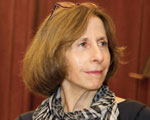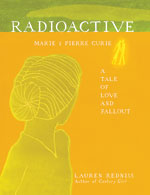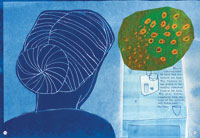Scholars in the Stacks
Every year at the New York Public Library’s Cullman Center, a new group of fellows finds something to write about By Richard Goodman Richard Goodman’s new book, The Bicycle Diaries: One New Yorker’s Journey Through September 11th, was recently published in a fine press edition by Midnight Paper Sales with original wood engravings by Gaylord Schanilec. Goodman is also the author of A New York Memoir, French Dirt: The Story of a Garden in the South of France, and The Soul of Creative Writing.
Located on the second floor of the New York Public Library’s Schwarzman Building on Fifth Avenue, behind heavy polished wood doors, is heaven for the fifteen men and women chosen to spend the academic year at the Dorothy and Lewis B. Cullman Center for Scholars and Writers. Each fellow has his or her own comfortable office, with computer, access to the entire NYPL collection, unlimited help from its learned curators—and let’s not forget the $60,000 stipend. The offices line the outer walls. In the center are couches and tables where fellows can sit and relax and talk. There’s a small kitchen as well. How are the fortunate few chosen?
 Jean Strouse, the director of the center and herself a writer (Alice James: A Biography and Morgan: American Financier), spoke to me about the process. “The Center’s selection committees look for first-rate writers, whether they’re novelists, poets, playwrights, independent scholars, visual artists, or academics—people whose work will engage a wide audience of intelligent readers and will make real contributions to our culture’s significant conversations,” she said. She then spoke enthusiastically about the interrelatedness of the experience the fellows enjoy. “The fellows have access to many things here, but one of the most powerful things we give them is each other. The first two or three weeks, they all hunker down and work, work, work. Then, gradually, they start to get know each other, and that’s when they start learning from each other. The scholars love being around the novelists. And the writers, who are often researching different eras in history for their novels, love being around the scholars, because they can teach them so much about research.”
Jean Strouse, the director of the center and herself a writer (Alice James: A Biography and Morgan: American Financier), spoke to me about the process. “The Center’s selection committees look for first-rate writers, whether they’re novelists, poets, playwrights, independent scholars, visual artists, or academics—people whose work will engage a wide audience of intelligent readers and will make real contributions to our culture’s significant conversations,” she said. She then spoke enthusiastically about the interrelatedness of the experience the fellows enjoy. “The fellows have access to many things here, but one of the most powerful things we give them is each other. The first two or three weeks, they all hunker down and work, work, work. Then, gradually, they start to get know each other, and that’s when they start learning from each other. The scholars love being around the novelists. And the writers, who are often researching different eras in history for their novels, love being around the scholars, because they can teach them so much about research.”
And it seemed to be true, this atmosphere of collegiality, the day I visited. Three or four fellows were bantering about a restaurant they’d been to and dinner plans they were making. Their projects are serious, though. The Cullman Fellows are among the elite in American letters. Among those in residence for 2010–2011 are Mary Gaitskill, author of the short story collection Bad Behavior and the novel Veronica; Annette Gordon-Reed, Harvard Law School professor and author of the Pulitzer Prize–winning The Hemingses of Monticello; and Larissa MacFarquhar, a staff writer for The New Yorker. Strouse mentioned former Cullman Fellows, an illustrious list that includes Ian Frazier, Colson Whitehead, and Edmund White.
She seemed especially proud of the book Radioactive: Marie & Pierre Curie: A Tale of Love and Fallout, by former fellow Lauren Redniss. This florid, smart, original book is now the basis for an exhibition in the Stokes Gallery of the Schwarzman Building that runs through April 17—the first ever based on the work of a Cullman Fellow. The New York Times called the book “a deeply unusual and forceful thing to have in your hands.” Much of the archival material upon which the book is based was found in the same building where Redniss sat during her fellowship year, 2008–2009.
I spoke with three of this year’s fourteen fellows—Sara Lipton, Michael Meyer, and Matthew Stewart. Their very different projects demonstrate the range and diversity of the fellows’ work.









